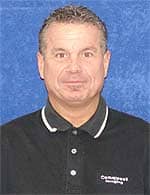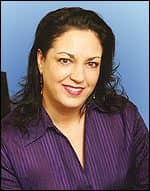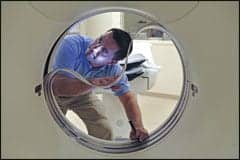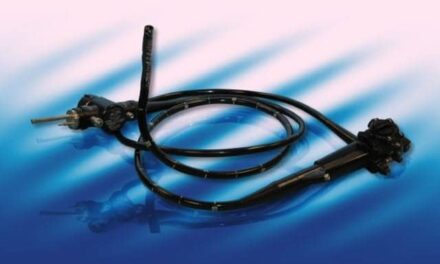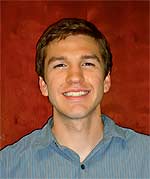
Kurt Woock
Over the course of nearly a decade, Paul Conrad has become familiar with practically every aspect of Stockton, Calif-based Conquest Imaging. Now the vice president of advertising and marketing, Conrad spends his time telling others about Conquest’s multifaceted approach to the ultrasound business. In short, Conquest offers reconditioned products, repair service, and training. During our conversation, Conrad discussed how Conquest is harnessing the Internet to enhance customers’ service experience, how the Affordable Care Act might affect the ultrasound industry, and the industry trends he is following closely.
24×7: How would you sum up what Conquest does?
Conrad: We offer ultrasound parts, probes, and service in California and Nevada, have probe repair, 24/7 technical support, and training.
24×7: Did you have any biomed experience before?
Conrad: My brother brought with him the technical end. As the company grew, I was able to provide more organization and infrastructure. I came in and put together the company employee handbook and operations manuals. What they had before was meant for a smaller company. I tied it all up so the company could run more efficiently. Then I went on to advertising and marketing. That’s what I’ve been doing for the past 3 years, VP of marketing and advertising.
24×7: We last spoke with you in December 2010. What is new with the company since then?
Conrad: For about a year, I’ve been working on a fully interactive Web site that we launched in August. It will give people the opportunity to speak with a customer service representative or the opportunity for customers to go on our Web site and pick a time for us to call them. There will also be 33 videos on the Web site with training videos added every month. So rather than calling tech support, they can download the video on their phone, go right up to the system, and view the instructions.
24×7: In what ways is Conquest continuing to evolve?
Conrad: I’m spearheading a research and development project—a transportation device for probes—we’re doing in conjunction with a major university. More than 80% of probe damage happens during transportation between departments. This device transports the probe in a safe, sterile manner. It will be ready to launch by the end of the year.
24×7: What is the awareness level of reconditioned parts?
Conrad: I’d say about 50%. We continue to promote through education and training the difference between a harvested part and a reconditioned part. Many times, a clinical engineer doesn’t know who to order a single part from, and they never think to look into the difference between harvested and reconditioned. If you open up a harvested part, you can see the difference. If it’s a part that’s been reconditioned, you’ll see really quickly what I mean: All the buttons are on it; you will not see dust bunnies; it will have a new membrane. We bring the parts back to meet or exceed factory-grade quality. If it’s not reconditioned, that machine is going to go down a lot quicker.
24×7: Conquest also provides training. Can you talk a bit about the people those classes are designed for and how those courses have evolved?
Conrad: We provide ultrasound training for the health care technology technicians. Our field service engineers, our internal engineers, and our work with clinical biomeds designed it. Our focus is training on the newest ultrasound equipment out there. It’s the nuts and bolts of how to get in, fix the system, and get out. Our program is focused on the front end and the back end. The classes, which can last 1 or 2 days, run about $1,800. Training programs elsewhere are often geared toward field engineers, whereas we focus on biomeds in hospitals, who make up to 80% of our clientele.
24×7: Do your clients or classes generally fit a certain profile, or do they come in all shapes and sizes?
Conrad: I get clients from all over the world. We had to bring in a Chinese translator last year. We train upward of 1,000 people per year. We have classes open to the public, and sometimes hospitals send in an entire group. We provide training for 26 pieces of ultrasound systems. We also train on the preventive maintenance (PM) of a system. The PM is one of the most popular classes.
24×7: What are the industry’s main challenges right now, and in the next 5 years?
Conrad: With national health care to start in 2014, hospitals are scrambling to meet the government financial efficiency standards in order to take part. To do this, hospitals are looking within themselves to see where they can save money. I think what you’re finding currently in the marketplace is that hospitals are finding fat where they didn’t think they had it. You’ll see hospitals running a lot more efficiently than ever before. They might be running up to a third more efficiently than before in terms of total cost. The biomed departments are canceling service contracts and are training themselves, becoming more knowledgeable than ever before on the operation and service of their own equipment.
24×7: What trends are you following?
Conrad: Over the last 2 years, hospitals have been moving all their equipment repairs internally. That trend will continue until on-site health care technology technicians will manage most equipment. We know for a fact that hospitals think health care is a big unknown. So, they’re not buying new equipment as quickly. They’re waiting to see what happens.
24×7: Have you tracked any other trends?
Conrad: I also believe that hospitals will be using the full life expectancy of their equipment, usually 10 or 15 years. It makes sense. Before, hospitals would use a piece of equipment for 5, 7 years, and then replace it. We expect the industry will keep ultrasound equipment longer and train their staff to maintain it. Of course, when the Affordable Care Act goes into effect, you’ll add 35 million people to the health care system immediately, so there will be an immediate need for new equipment, but in the end what you’ll see is that equipment will be expected to live out the full life span of that equipment.
24×7: To this point, why the quick turnover in equipment?
Conrad: There are many factors why hospitals change equipment so quickly. A hospital might want to attract a new doctor. They might want to offer a different type of exam. And you’ll get users who go off to training and sit in front of the newest and greatest monitor or something, and come back and think theirs has a problem—well, no, not necessarily. Some hospitals think 5 years is outdated. It might be 5 years old, but it still does what it should be doing and at the level that it’s expected to do it.
24×7: How is Conquest Imaging part of the solution?
Conrad: Our training department, over the last year, has doubled the number of students due to expanding the systems we train on as these systems—GE Voluson E8, GE Logic E9, Philips HD11, and Siemens S2000—are fairly new to the industry, and due to clinical engineering departments bringing ultrasound service in-house.
Kurt Woock is the associate editor of 24×7. Contact him at .


